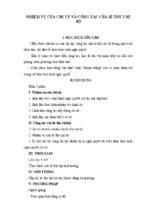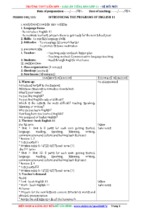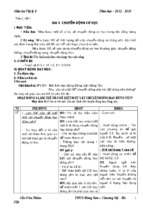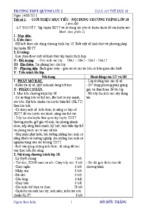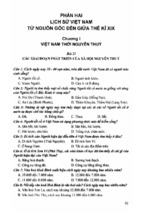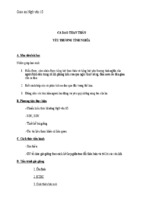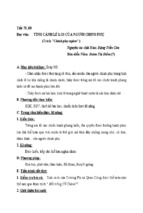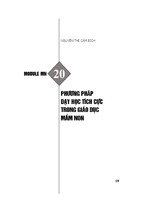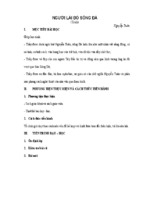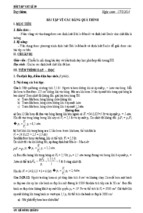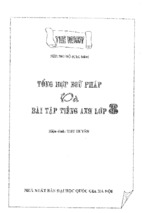Chu Quang B×NH
ThiÕt kÕ bµi gi¶ng
11
N©ng cao − TËp hai
Nhµ xuÊt b¶n Hµ néi
1
ThiÕt kÕ bµi gi¶ng
tiÕng anh 11 - n©ng cao, tËp hai
chu quang b×nh
Nhµ xuÊt b¶n Hµ néi
ChÞu tr¸ch nhiÖm xuÊt b¶n:
NguyÔn kh¾c o¸nh
Biªn tËp:
Ph¹m quèc tuÊn
VÏ b×a:
Tµo thu huyÒn
Tr×nh bµy:
th¸i s¬n − s¬n l©m
Söa b¶n in:
ph¹m quèc tuÊn
In 1000 cuèn, khæ 17 x 24 cm, t¹i C«ng ty cæ phÇn in Khoa häc vµ C«ng
nghÖ míi. GiÊy phÐp xuÊt b¶n sè: 208 − 2007/CXB/46 e TK − 47/HN.
In xong vµ nép l−u chiÓu quý I/2008.
2
Unit 9
nature in danger
Period 1 & 2
(Reading)
I. Aim
Reading a passage about environmental problems on Mt. Everest
II. Objectives
By the end of the lesson, Ss will be able to:
− talk about common activities that people often do when they visit
national parks and tourist attractions and the current problems in Viet
Nam’s national parks and tourist attractions through various activities in
class.
− enrich background knowledge on expeditions to Mt. Everest.
− improve mirco-reading skill by answering questions and finding the
words for the given definitions.
III. Materials
Textbook, whiteboard markers,...
Pictures of national parks and famous tourist attractions
LCD screen showing tourist attractions if possible
IV. Anticipated problems
Ss may not have proper background knowledge on the topic so T should
provide necessary related information.
V. Procedure
Time
Steps
15’
Warm-up
Give brief information about the given tourist
attractions:
Work
arrangement
Whole class
and Group
3
Time
Steps
A national park in Dong Thap Muoi, Dong Thap
Province. This national park is created to protect
several rare birds, especially Sarus Crane (grus
antigone), a species listed in Red Book.
The highest mountain in Japan located near the
Pacific coast of central Honshū.
A large rock formation located in Uluru-Kata Tjuta
National Park in Central Australia.
The world's first national park on March 1, 1872
located in the USA.
The highest mountain on earth located on the border
between Nepal and Tibet, China. It is sometimes
called Chomolungma.
A national park and UNESCO World Heritage Site in
the center of Quang Binh province in north-central
Viet Nam.
Ask Ss to work in groups to match the national parks
and tourist attractions in the book with the above
information and then match them with the pictures.
Call on some Ss to give their answers in front of the
class.
Gather ideas and give correct answers:
1. Ayers Rock is a large rock formation located
in Uluru-Kata Tjuta National Park in Central
Australia. b
2. Tram Chim is a national park in Dong Thap
Muoi, Dong Thap Province. This national park
is created to protect several rare birds,
especially Sarus Crane (grus antigone), a
species listed in Red Book. e
4
Work
arrangement
work
Time
Steps
Work
arrangement
3. Mt. Everest is the highest mountain on earth
located on the border between Nepal and
Tibet, China. It is sometimes called
Chomolungma and considered as the roof of
the world. a
4. Mount Fuji is the highest mountain in Japan
located in the Mount Fuji National Park near
the Pacific coast of central Honshū. f
5. Phong Nha Cave is a cave, a national park
and UNESCO World Heritage Site in the
center of Quang Binh province in northcentral Viet Nam. c
6. Yellowstone is the world's first national park
on March 1, 1872 located in the USA. d
15’
Pre-reading
What may be harmful to the environment?
Ask Ss to look at the activities that tourists often do
when they visit the national parks and tourist
attractions.
Group work
Explain some of the activities which may cause
difficulties to Ss.
Have Ss work in groups and discuss the activities
normally done by tourists which may be harmful to
the environment.
Call on some Ss to explain their answers in front of
the class.
Feedback and give correct answers:
Activities tourists often do:
- make a campfire (all of these places)
- have a swim (c, d, f)
- carve names or drawings on rocks (a, b, c, f)
5
Time
Steps
- eat and drink (all of these places)
- take photos (all of these places)
- pick flowers or break tree branches (b, e, f)
- dispose of garbage (all of these places)
- go boating (c, d, e, f)
Activities which may be harmful to the environment:
- make a campfire (may cause a forest fire)
- carve names or drawings on rocks (may destroy
the beauty of nature)
- break tree branches (may harm trees)
- dispose of garbage (will pollute the environment)
- go boating (will bring about waves that may
cause soil erosion at the banks)
Vocabulary pre-teach
junkyard (n): a place where junk (abandoned or
unimportant things) is thrown or collected (nơi tập kết
đồ phế liệu, bãi rác)
hallucinate (v): to perceive a non-existent object or
phenomenon; to believe that one is experiencing
something which in reality does not exist; to
experience a hallucination (gợi ảo giác)
fuel canister (n): a small box or case for holding fuel
(bình đựng nhiên liệu)
summit (n): top, peak of something (mountain) (đỉnh
núi)
cleanups: campaigns or programs to make the
environment clean (chiến dịch làm sạch môi trường)
deposit (n): an amount of money given as part
payment or as security (tiền đặt cọc)
authority (n): government; the persons or the body
exercising power or command (chính quyền)
6
Work
arrangement
Time
Steps
Work
arrangement
Checking technique
Rub out and remember
Write all the new words on the board in two columns:
English and Vietnamese equivalents.
Rub out all the words in the English column and ask
Ss to look at the Vietnamese column to write down or
read aloud the rubbed ones.
While-reading
10’
15’
Set the scene
For a long time, exploring our world has been
human’s passion and the peak of Mt. Everest, the
highest mountain in the world, has been conquered by
a number of tourists. However, expeditions of tourists
has put the environment of Mt. Everest at risk. In
today’s reading, we will read about Mt. Everest and
its problems.
Task 1 - Choosing the best title
Have Ss scan the passage and choose the best title
for it.
Note that the title must convey the main idea of the
passage. The other three options may be correct but
they fail to cover the major points of the reading.
Call on some Ss to give their answers in front of the
class.
Ask for Ss’ explanations.
Give correct answer:
The best title of the text is a): Mt. Everest’s
Environmental Problems and Solutions
Task 2 - Answering questions
Tell Ss to read the text individually and more
carefully to answer the questions in b).
Individual
work
Individual
work
7
Time
Steps
Work
arrangement
Ask Ss to underline or highlight the information
which provides the answers.
Call on some Ss to read aloud their answers in front of
the class.
Feedback and give correct answers.
1. Because Mt. Everest – the highest place on
earth – has a lot of garbage now.
2. They need oxygen bottles when they climb to the
height of more than 7,000 meters, where there
is not enough oxygen to breathe in.
3. They need fuel canisters, oxygen bottles,
batteries, foods, and drinks.
4. The Sherpas pick up garbage, put it in their
backpacks, and bring it down to the foot of the
mountain.
5. They collected more garbage in 1998 than they
had done in 1995.
6. This is a measure to force tourists not to leave
their equipment on the mountain. If they do so,
they cannot get back the deposit.
15’
Task 3 - Finding words and expressions
Ask Ss to continue working on their own and find the
words and expressions in the text with meanings
given in the book.
Note: If Ss are at lower level, T may provide the
paragraph which contains the word or expression.
Have Ss compare their words with a friend.
Call on some Ss to write their answers on the board.
Check the answers in front of the class as a whole.
Give correct answers:
8
Individual
work and
Pair work
Time
Work
arrangement
Steps
1. hallucinate
2. explode
3. summit
4. attempt
5. deposit
15’
Post-reading
Have Ss work in groups and discuss the question:
Group work
What are some current problems in Viet Nam’s
national parks and tourist attractions? Suggest
solutions.
Encourage all members in the groups to actively
engage in the discussion and contribute relevant ideas.
Call on some Ss to present their ideas in front of the
class.
Make necessary comments and corrections.
Give suggested ideas.
Problems
- Pollution (caused by
littering)
- Extinction of some species
of animals (caused by
illegal hunting)
- Erosion and flooding
(caused by felling trees)
- Forest fire (caused by
smoking)
Solutions
- Raise people’s awareness
about the environmental
issues and wildlife
protection.
- Impose heavy fines on
people who litter garbage
and hunt illegally.
- Urge people to stop felling
trees and immediately to
prevent floods and
erosions.
9
Time
5’
Steps
Wrapping
Summarize the main points.
Work
arrangement
Whole class
Assign homework.
Supplements
Extra reading
1. List of national parks in Viet Nam
1. Ba Bể National Park (Bắc Kạn)
2. Ba Vì National Park (Hà Tây)
3. Bạch Mã National Park (Thừa Thiên-Huế)
4. Bái Tử Long National Park (Quảng Ninh)
5. Bến En National Park (Thanh Hóa)
6. Bù Gia Mát National Park(Bình Phước)
7. Cát Bà National Park (on Cát Bà Island, Hải Phòng)
8. Cát Tiên National Park (Đồng Nai, Lâm Đồng, and Bình Phước)
9. Chu Mom Ray National Park (Kon Tum)
10. Chư Yang Sin National Park (Dak Lak)
11. Côn Đảo National Park (Bà Rịa-Vũng Tàu)
12. Cúc Phương National Park (Ninh Bình, Thanh Hóa, and Hòa Bình)
13. Hoàng Liên National Park (Lào Cai)
14. Kon Ka Kinh National Park (Gia Lai)
15. Lò Gò Xa Mát National Park (Tây Ninh)
16. Mũi Cà Mau National Park (Cà Mau)
17. Núi Chúa National Park (Ninh Thuận)
18. Phong Nha-Kẻ Bàng National Park (Quảng Bình)
19. Phú Quốc National Park (Kiên Giang)
20. Pù Mát National Park (Nghệ An)
21. Tam Đảo National Park (Vĩnh Phúc, Thái Nguyên and Tuyên Quang)
22. Tràm Chim National Park (Đồng Tháp)
23. U Minh Thượng National Park (Kiên Giang)
24. Vũ Quang National Park (Hà Tĩnh)
25. Xuân Sơn National Park (Phú Thọ)
26. Xuân Thuỷ National Park (Nam Định)
27. Yok Don National Park (Dak Lak)
10
2. Facts About Mt. Everest
•
•
Highest mountain in the world – 8848m.
Number of people to attempt to climb Mt. Everest: approximately
4,000.
•
Number of people to successfully climb Mt. Everest: 660.
•
Number of people who have died trying to climb Mt. Everest: 142.
•
•
Height: 29,028 feet, or 5 and a half miles above sea level. This is
equivalent to the size of almost 20 Empire State Buildings.
Location: part of the Himalaya mountain range; straddles border of
Nepal and Tibet.
•
Named for: Sir George Everest, a British surveyor-general of India.
•
Age: approximately 60 million years old.
•
•
•
•
Other names: called "Chomolungma" by Tibetans and Sherpas, which
means "Mother Goddess of the Earth."
Countries visible from the summit: Tibet, India, and Nepal.
First people to climb to the summit: Edmund Hillary and Tenzing
Norgay on May 29, 1953.
Notable dates:
1921 - Dalai Lama allowed British reconnaissance party to visit Tibet
and the northern side of Mt. Everest.
1924 - British explorers George Mallory and Andrew Irvine
disappeared near the summit, along the Northeast Ridge. It was
possible that they may have actually been the first to reach the
summit, but they never returned.
1949 - Nepal opened its borders, making access to the mountain's
southern peak possible.
1953 - Hillary and Norgay reached summit.
1963 - First Americans reached the summit.
1989 - First two women, both American, reached the summit.
1990 - Sir Edmund Hillary's son, Peter, reached summit.
1996 - Eleven people died during spring expeditions.
11
Period 3
(Listening)
I. Aim
Listening to a conversation about the effects of ecotourism on environment
II. Objectives
By the end of the lesson, Ss will be able to:
− talk about the effects of ecotourism on environment by using environmentrelated words such as hunting, environment-friendly, awareness, dolphin,
whale,...
− enrich background knowledge on ecotourism.
− enhance listening skill through True or false and Table completion exercises.
III. Materials
Textbook, whiteboard markers, cassette,...
IV. Anticipated problems
Ss may not understand the concept of ecotourism thoroughly so T should
give necessary background information to make sure Ss understand the
concept before listening to the tape.
V. Procedure
Time
Steps
Work
arrangement
Warm-up
7’
Pictures recognition
Have Ss work in groups of four and discuss what
they see in the pictures/ what ecotourists in the
pictures might be doing.
Note that they are common activities that people
do when they are on holiday.
Call on some Ss to explain their answers in front of
the class.
Accept the answers in Vietnamese and provide
English equivalents later.
12
Group work
Time
Steps
Work
arrangement
Give suggested answers:
a. Some ecotourists are watching birds with
binoculars.
b. Two tourists are riding an elephant.
c. A lot of tourists are taking a boat trip along a
canal (or a river).
d. Tourists are hiking / walking in the forest.
e. Some tourists are making a campfire.
f. A lot of tourists are watching a whale swimming
in the sea.
Ask further questions to make sure Ss understand
the activities such as: Are these activities good or
bad to the environment?
Which activity do you like best?
Which one have you tried? Which one do you wish
to try?
...
5’
Pre-listening
Briefly explain the definition of an ecotour.
Pair work
An ecotour is a small, individually guided tour that
takes conservation and preservation issues into
consideration, donates to the local economy, and
teaches the travelers something about the nature
and culture of the area in which they are located.
Activities on an ecotour
Ask Ss to work in pairs and discuss:
What might you do if you go on an ecotour?
Gather ideas from Ss and lead in the listening.
13
Time
Steps
Work
arrangement
Introduce some new words which might cause
difficulties to Ss while listening to the tape:
environment-friendly (a): thân thiện với môi
trường
wildlife (n): cuộc sống hoang dã
awareness (n): nhận thức
flash (n): đèn pin
...
While-listening
Set the scene
Mr. Christ Green, an environmentalist, is invited
to talk to students of Le Lai High School about the
effects of ecotourism. Listen to the first part of his
talk and check (√) whether the statements are true
(T) or false (F).
10’
Task 1 - True or false
Have Ss read the statements carefully before
listening to the tape.
Tell Ss to highlight or underline the key words if
necessary.
Play the tape twice so that Ss can be sure about
their answers.
Have Ss compare their answers with a friend.
Check and give correct answers:
14
1.
F (Surely not. Tourists don’t go hunting.)
2.
T
3.
T
4.
F (Many activities cause harm to the
environment.)
Individual
work
Time
Steps
10’
Task 2 - Table completion
Instruct the task carefully: Ask Ss to listen to the
tape and complete the table with two columns of
ecotour activities and their effects.
Work
arrangement
Individual
work
Play the second part of the talk several times if
necessary.
Have Ss exchange their answers and discuss them.
Pause at certain points which contain the answers.
Give correct answers:
1. (Watching) whales of dolphins
2. (Noise from boats) disturbs whales and
dolphins, which can become stressed and eat
less.
3. (Watching) birds
4. (The strong light from the flashes) might
frighten the birds.
5. (Walking) on the grass and plants
6. (The vegetation) might be harmed, which causes
soil erosion when there are heavy rains.
Listening script
b)
Mr. Green:
Hello, everyone. Today I’ll talk
about the effects of ecotourism on
our environment. Anybody here
knows what ecotourism is?
(Male voice):
Is it for tourists who want to go
hunting?
(Female voice): Surely not. I read from books that
it’s for those who want to know
more about nature.
15
Time
Steps
Mr. Green:
You’re right. Ecotourists are
interested in watching wildlife
without destroying nature.
(Female voice): So ecotourism is environmentfriendly, isn’t it?
Mr. Green:
Yes and no. Many tourists have the
intention of protecting wildlife,
but many of their activities cause
harm to the environment without
their awareness.
(Female voice): This means they don’t know
they’re harming wildlife?
Mr. Green:
No. Probably not.
c)
(Female voice): I don’t quite understand. Why
don’t they know they’re harming
wildlife?
Mr. Green:
Let me give you an example. To
watch the whales or dolphins,
people travel in boats. The noise
from the engines of these boats
disturbs these animals, and they
may get stressed or eat less.
(Female voice): I see. But Mr. Green, when people
watch the birds, they don’t make
any noise at all!
16
Mr. Green:
Right. But they take photographs
and the strong light from the
flashes frightens the birds.
(Male voice):
How about the effects on flowers
and trees, Mr. Green?
Work
arrangement
Time
Steps
Mr. Green:
Work
arrangement
You mean the vegetation. Yes,
tourists usually walk on the same
path over time, and this may harm
the ground cover – I mean the
grass or wild plants that cover
and protect the soil.
(Female voice): What happens then?
(Male voice):
10’
Without this cover, the soil is
washed away when there are
heavy rains. Now, let’s talk about
the fires...
Post-listening
Have Ss work in pairs and discuss possible effects
other ecotour activities might have on wildlife or
the environment.
Go round the class and provide Ss with necessary
support.
If time allows, call on some Ss to present their
ideas in front of the class.
Make necessary comments and corrections.
Give suggested answers:
- Buying objects made from endangered species
(ivory, coral, seashells, etc) may encourage
illegal hunting or killing of these species.
- Littering might pollute the environment.
- Feeding animals may change their eating habits
and cause their unhealthy dependency on men’s
source of food.
- Touching animals can transmit diseases to them,
which are already in danger.
- Boating might cause soil erosion.
Pair work
17
Time
3’
Steps
Wrapping
Summarize the main points.
Work
arrangement
Whole class
Assign homework.
Supplements
Extra reading
ecotourism
Definitions
Defining "Ecotourism" has proven to be a difficult task given all the different
players attempting to define it. People tend to define things in terms that are
beneficial to themselves, hence the variety of definitions. There are, however,
several workable definitions currently in wide use.
The International Ecotourism Society defines Ecotourism as: "responsible
travel to natural areas that conserves the environment and improves the
welfare of local people".
The Australian Commission on National Ecotourism Strategy calls it: "naturebased tourism that involves education and interpretation of the natural
environment and is managed to be ecologically sustainable".
Features
1) Involves travel to natural destinations. These destinations are often
remote areas, whether inhabited or uninhabited, and are usually under
some kind of environmental protection at the national, international,
communal or private level.
2) Minimizes Impact. Tourism causes damage. Ecotourism strives to
minimize the adverse affects of hotels, trails, and other infrastructure by
using either recycled materials or plentifully available local building
materials, renewable sources of energy, recycling and safe disposal of
waste and garbage, and environmentally and culturally sensitive
architectural design. Minimization of impact also requires that the
18
numbers and mode of behavior of tourists be regulated to ensure limited
damage to the ecosystem.
3) Builds environmental awareness. Ecotourism means education, for both
tourists and residents of nearby communities. Well before departure tour
operators should supply travelers with reading material about the country,
environment and local people, as well as a code of conduct for both the
traveler and the industry itself. This information helps prepare the tourist
as The Ecotourism Societies guidelines state"to learn about the places and
peoples visited" and "to minimize their negative impacts while visiting
sensitive environments and cultures". Essential to good ecotourism are
well-trained, multilingual naturalist guides with skills in natural and
cultural history, environmental interpretation, ethical principles and
effective communication. Ecotourism projects should also help educate
members of the surrounding community, schoolchildren and the broader
public in the host country. To do so they must offer greatly reduced
entrance and lodge fees for nationals and free educational trips for local
students and those living near the tourist attraction.
4) Provides direct financial benefits for conservation: Ecotourism helps
raise funds for environmental protection, research and education through a
variety of mechanisms, including park entrance fees, tour company, hotel,
airline and airport taxes and voluntary contributions.
5) Provides financial benefits and empowerment for local people: National
Parks and other conservation areas will only survive if there are "happy
people" around their perimeters. The local community must be involved
with and receive income and other tangible benefits(potable water, roads,
health clinics, etc.) from the conservation area and it's tourist facilities.
Campsites, lodges, guide services, restaurants and other concessions
should be run by or in partnership with communities surrounding a park or
other tourist destination. More importantly, if Ecotourism is to be viewed
as a tool for rural development, it must also help shift economic and
political control to the local community, village, cooperative, or
entrepreneur. This is the most difficult and time-consuming principle in the
economic equation and the one that foreign operators and "partners" most
often let fall through the cracks or that they follow only partially or
formally.
19
6) Respects local culture: Ecotourism is not only "greener" but also less
culturally intrusive and exploitative than conventional tourism. Whereas
prostitution, black markets and drugs often are by-products of mass
tourism, ecotourism strives to be culturally respectful and have a minimal
effect on both the natural environment and the human population of a host
country. This is not easy, especially since ecotourism often involves travel
to remote areas where small and isolate communities have had little
experience interacting with foreigners. And like conventional tourism,
ecotourism involves an unequal relationship of power between the visitor
and the host and a commodification of the relationship through exchange
of money. Part of being a responsible ecotourist is learning beforehand
about the local customs, respecting dress codes and other social norms and
not intruding on the community unless either invited or as part of a well
organized tour.
Period 4
(Speaking)
I. Aim
Giving explanations of actions
II. Objectives
By the end of the lesson, Ss will be able to:
− use appropriate expressions to give explanations of the actions done on
an ecotour.
− discuss in-depth the DOS and DON’TS on an ecotour.
III. Materials
Textbook, whiteboard markers,...
Pictures of Phong Nha Cave, Mount Fuji and Tram Chim National Parks
IV. Anticipated problems
Some activities on an ecotour may be unfamiliar with Ss. Ts should be
ready to help.
20
- Xem thêm -

